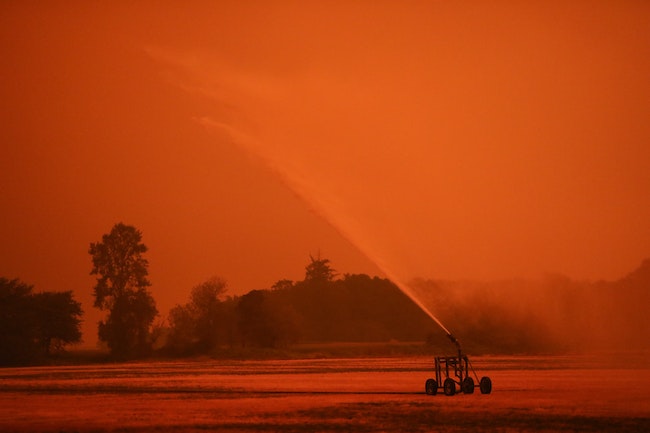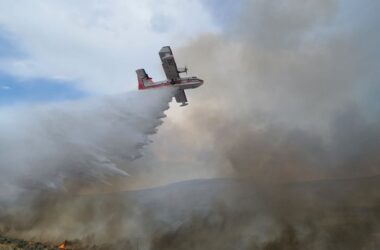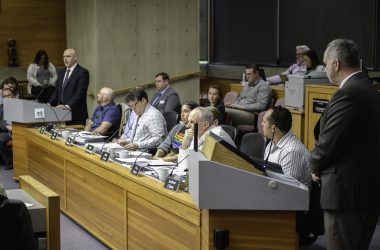
A sprinkler waters a field amidst wildfire smoke in Aumsville on Tuesday, September 8. (Amanda Loman/Salem Reporter)
In June 2019, Pacific Power representatives attended a community fair in Happy Camp, California, 20 miles south of the Oregon border, to share highlights of the wildfire prevention plan the company had been required to file months earlier with California regulators.
The plan showed that Happy Camp is directly west of one of the highest risk areas for wildfire in Pacific Power’s rural California service territory. As residents munched hot dogs, the utility’s representatives explained its plans to preemptively cut off power in a zone around Happy Camp to protect the community when it was most at risk. Blackouts aren’t popular, and they would only be used as a last resort. But better safe than sorry.
Utility officials explained they would potentially cut power when forecasts and real time weather data exceeded defined benchmarks, including wind speed, drought conditions and potential for fire spread.
Fourteen months later, those conditions arrived. An extreme windstorm that had been forecast for days was pushing down the West Coast. It was already feeding a series of wildfires in Oregon and Washington, some of them sparked by downed power lines.
But Pacific Power never pulled the plug in Happy Camp — or elsewhere on Labor Day.
While Pacific Power wasn’t required to cut electricity, an investigation by The Oregonian/OregonLive found that forecasts for the area — then actual weather conditions within the power shutoff zone — surpassed the thresholds the utility had established for preemptive blackouts.
Meanwhile, in communities to the east and west of Happy Camp, California’s largest electric utility, Pacific Gas & Electric, had shut off electricity on Monday evening, citing critical risks and the high probability that winds could take down power lines and start fires. Large utilities further south did the same, and in Oregon, Portland General Electric also shut off power to 5,000 customers on the shoulder of Mt. Hood on the evening of Sept. 7.
What came to be known as the Slater Fire ignited about 6:40 a.m. on Tuesday, Sept. 8, near the Slater Butte fire lookout, a site within Pacific Power’s designated Happy Camp power shut-off zone where the utility operates transmission and distribution lines. Stoked by the intense winds, it grew into a conflagration that eventually burned 157,000 acres in California and Oregon, destroyed 440 structures and killed two people.
Six months later, the fire’s cause is still under investigation. But a lawsuit filed against the company alleges it started when a white fir tree weakened by rot and disease failed and fell into Pacific Power’s power lines on Slater Butte. Anecdotal accounts also point to power lines.
Kirk Eadie, a pastor and ambulance driver in Happy Camp, says that’s what he heard on his emergency radio Tuesday morning as fire crews responded to the blaze.
“If they would have done what they said they were going to do, there would have been no power during that time and we would still see a beautifully lush green forest,” he said. “Two people would still be alive.”
Whether or not Pacific Power is found at fault, the devastation in Happy Camp is relevant to Oregonians because PacifiCorp — the utility’s Portland-based parent company — is the state’s largest rural service provider and its territory in Oregon overlaps with many areas deemed at extreme risk of wildfires.
PacifiCorp is facing multiple lawsuits stemming from the Labor Day wildfires. They allege the utility is responsible for fires that devastated the Santiam Canyon, the Archie Creek fire along the North Umpqua, and the Slater fire, which eventually burned over the state line into Josephine County. Collectively, the fires burned nearly a half million acres, 800 homes, nearly 1,300 other structures and killed seven people.
Happy Camp is unique in one way, however, as it is the only one of those areas where PacifiCorp had identified extreme wildfire risks and had a shutoff plan in place.
If PacifiCorp is found at fault in the lawsuits, its liability could be enormous, potentially affecting customers’ rates. It also raises the question of whether the company is fundamentally underestimating wildfire risks on the west side of the Cascades, whether it should have been more proactive, and how Oregon lawmakers and regulators should structure new rules governing preemptive blackouts.
The company declined to answer specific questions from The Oregonian/OregonLive about the Slater fire and its decision process for cutting power on Labor Day. The company had never implemented a so-called public safety power shutoff before, but undertook one in the neighboring community of Weed on Sept. 13, five days after the Slater fire.
“Shutting off our customers’ power is not something we take lightly,” said Drew Hanson, a spokesman for the company, adding that deenergizing lines can make it more difficult for emergency services to respond. “We make decisions based not just on available forecasts but also on a detailed synthesis and deep understanding of what is happening on the ground in the community.”
California requires utilities to submit updated wildfire prevention plans annually, file detailed reports when they shut off electricity for emergencies, and quickly provide regulators with a report on certain fires in their service territory, including their cause and estimated damages.
Oregon has none of those requirements or regulations.
The Oregon Public Utility Commission says it has the authority to investigate wildfires caused by power lines and levy fines, but it hasn’t acted on that authority — as California’s regulatory agency has. And Oregon’s utility commissioners failed to ask Oregon’s two largest electricity providers whether power lines were implicated in last fall’s fires.
The Labor Day firestorm on the west side of the Cascades was severe, experts say, beyond anything in living memory. But they predict large wildfires will be more frequent as climate change races forward, and that power lines will remain a significant, but often preventable risk.
Tim Ingalsbee, executive director of Eugene-based Firefighters United for Safety, Ethics and Ecology, calls many of the Labor Day fires “an avoidable tragedy, where the solution was literally as simple as flipping a switch.”
“We at least need to match California’s regulatory standards, but we probably need to exceed them in accountability standards,” he said. “Having the most perfect wildfire plan in place is not worth the paper it’s printed on if it’s not implemented.”
PacifiCorp’s fire safety plans
Wildfire prevention and preemptive blackouts have been a controversial and fast-evolving issue for the last decade in California, as the state has experienced record-breaking and longer wildfire seasons and more frequent power shutoffs during periods of high risk.
Oregon has seen similar wildfire trends. But it was California’s devastating Camp fire, a power-line sparked wildfire that destroyed the town of Paradise and killed 85 in Nov. 2018, that spurred Oregon regulators to address the issue more aggressively.
As part of its work in both states, Pacific Power has identified areas of its service territory considered at “elevated” and “extreme” risk for wildfires, whether because of fire history, topography or weather conditions during fire season. Those include portions of Hood River, southern Oregon and Northern California.
The fire science continues to evolve, and meteorologists and ecologists have developed numerous ways to measure fire ignition and spread potential. Pacific Power’s 2019 wildfire prevention plan in California established a customized set of benchmarks for power shutoffs that rely on three key variables:
- Wind speeds
- The moisture level in dead debris on the ground, measured by the Keetch Byrum Drought Index
- The risk of fire spread, measured by the Fosberg Fire Weather Index, which combines wind speeds, relative humidity and air temperatures
In addition, the utility identifies “Tier 3” zones, where wildfire risks are considered extreme. In Happy Camp, which neighbors a “Tier 3” zone, an internal alert is supposed to be triggered when forecasts predict:
- Sustained winds of 16 mph or gusts over 25 mph
- A Keetch-Byrum Index of 622 or higher on a scale of 800
- A Fosberg value, averaged over six hours, of 30 or higher on a scale of 100
If the wind intensifies, and gusts top 31 mph, Pacific Power says it activates its emergency operations center and starts notifying its customers of a potential preemptive blackout.
In 2020, Pacific Power nearly doubled the Fosberg and Keetch-Byrum thresholds that would trigger a power shut-off in Happy Camp from 2019 levels. There was no explanation for the change in the company’s 2020 filing and the company didn’t answer a question about why it was made.
Plans filed with California regulators show that two Pacific Power executives decide whether to move forward with a public safety power shutoff: the vice president of operations and the vice president of transmission and distribution operations.
The company declined to make any executive available for comment.
Conditions and forecasts
The extreme weather conditions that stoked the Labor Day firestorms in Oregon and California were no surprise. Forecasters had been broadcasting critical fire weather bulletins for days, pointing repeatedly to unusually dry ground cover in the forests, the potential for extreme winds, high temperatures and very low humidity levels.
The National Weather Service’s Medford office, which covers Northern California, started issuing warnings on Thursday Sept. 3 about the possibility of significant east winds and a heatwave on Labor Day. It upgraded the forecast to a Red Flag Warning on Saturday Sept. 5, calling for winds of 20 mph to 25 mph, gusts to 40 mph and humidity as low as 10% from 11 pm Monday through midnight Tuesday. The warnings were repeated on Sunday, with progressively higher winds and lower humidity levels forecast in the area that included Happy Camp.
Forecasters added to the warning on Monday. They said a “critical fire weather pattern” would remain through Wednesday. Due to high wind speeds, they stressed the possibility of downed power lines and poles creating further risks.
California Predictive Services was delivering equally dire warnings, with much of the state under a fire watch, including the area around Happy Camp.
Plugging those forecasts into Pacific Power’s fire risk metrics is fairly straightforward. Predicted winds speeds are an obvious variable. And with drought conditions prevailing in northern California, the Keetch-Byrum Drought Index was well above the threshold Pacific Power had established for much of the summer. By early September on Slater Butte, it was hovering near the 90th percentile of measured levels, close to its maximum value of 800.
It’s also possible to predict the Fosberg Fire Weather Index for a specific geography by plugging expected wind, relative humidity and temperatures into an index calculator. And based on the prevailing external forecasts for the Happy Camp area on Labor Day weekend, the predicted value of the index would have been far above the threshold Pacific Power had established to trigger a potential shutdown.
Likewise, other measures that experts use to measure fire risk, including the Energy Release Component and Burn Index were above the 97th percentile at the National Weather Service’s station on Slater Butte on Sept 5, 6 and 7. The Burn Index spiked to an all-time high on the day the fire ignited, according to Matt Jolly, a research ecologist at the U.S. Forest Service’s Fire Sciences Laboratory in Missoula. The Severe Fire Danger Index was also at its highest level on Slater Butte in the days leading up to the fire.
It’s unclear what conversations were taking place within Pacific Power at the time. According to the utility’s plan, Pacific Power takes external weather forecasts into account, including Red Flag Warnings, but considers them too high level and generic to be a key input in the decision to cut off power at a particular location. Instead, Pacific Power relies on data from a small network of its own weather stations, and forecasts at those locations are provided by a third party, the Western Weather Group, according to its regulatory filings.
The company had plans for 35 weather stations, but only 10 were installed by the end of 2019. One is located near Happy Camp and another just to the east in Seiad Valley, California.
It’s unclear what those forecasts were predicting. The company declined to share them with The Oregonian/OregonLive. It also declined to say whether any internal notifications were issued or whether it activated its emergency operations center prior to the fire. No notifications were issued to residents.
It’s also not clear if Pacific Power had its own chief meteorologist on staff in September. The company was advertising the position during the fall, a job described on its website as “taking the role as the lead forecaster during periods of critical fire danger.” PacifiCorp declined to say whether that position was open during Labor Day.
Meanwhile, Pacific Gas & Electric, the California utility that serves a broad swath of Northern California, including customers to the east and west of Happy Camp, took heed. It’s 152-page post-event report to California regulators said it activated its emergency operations center at noon on Friday Sept. 4 because of its own weather models and external forecasts. On Saturday evening, it issued direct customer notifications, posted the outage information on its website, contacted more than 200 community organizations, and made calls and in-person visits to medically vulnerable customers to alert them before the power was shut off.
On the evening of Sept. 7, PG&E cut power to 172,000 customers. The shutoff lasted until Sept 9, when forecasts indicated that the winds had subsided and were not expected to return. Crews began inspecting and patrolling lines in all areas and reenergizing lines. Those inspections found 59 cases of direct damage to its equipment from vegetation or wind, and another 24 cases of hazards that could have started a fire if there wasn’t a blackout, such as a tree limb found suspended in electrical lines.
The Fosberg
The Fosberg Fire Weather Index, which is central to Pacific Power’s shutoff plan, is not a universally popular indicator among utilities.
San Diego Gas and Electric evaluated its use of the index to predict fire growth potential in Southern California generated by Santa Ana winds. But in 2015 testimony to California regulators, a utility meteorologist said the index was too volatile and can generate false positives.
Pacific Power appears to deal with that volatility by averaging the index value over six hours, and setting its power cutoff threshold to that average. But that means the utility can be looking at real-time wildfire risks in hindsight, as it was on the evening of Sept 7.
The company’s regulatory filings don’t say whether Pacific Power monitors data from other weather stations within its service territory and transmission footprint, such as the U.S. Forest Service weather station on Slater Butte, where the fire erupted. Data from that station is updated less frequently — hourly versus every ten minutes — than at Pacific Power’s weather stations. But it is directly adjacent to the utility’s transmission and distribution lines and within the Happy Camp power shutoff zone. And it tracks all three weather variables that are used to calculate the Fosberg.
The Oregonian asked Scott Goodrick, the director of meteorology at the U.S. Forest Service’s Southern Research Station, to calculate the six-hour Fosberg Fire Weather values for Sept 7 and 8 at the National Weather Service station on Slater Butte, 2,900 feet above Happy Camp. The data show that before midnight on Sept. 7 – nearly seven hours before the fire was spotted — wind speeds, the Keetch-Byrum index and the Fosberg six-hour average had crossed levels that Pacific Power had established to trigger a possible power shutoff.
At Pacific Power’s weather station in Happy Camp, conditions were somewhat calmer. The data show winds started picking up about 3:30 a.m. In real time — not the six-hour average — that pushed the Fosberg value over Pacific Power’s benchmark of 30, where it would remain until that evening. PacifiCorp’s six-hour Fosberg average, however, took time to catch up.
Based on data from the weather station, it wasn’t until 7:10 a.m. that the six-hour Fosberg average surpassed 30, and not until 8:20 a.m. that all three threshold variables were surpassed to trigger customer notifications and a potential blackout.
By that time, the Slater fire was already raging down the mountain toward Happy Camp.
Again, no official cause of the fire has been released. But California regulators also require electric utilities to report fires involving injuries, damages of more than $50,000 or significant media coverage. They are supposed to notify regulators within hours, provide the cause and estimated damages, then follow up with a more detailed written report within 20 business days.
Other utilities’ incident reports from last fall’s fires include a summary describing any electrical issues on their grids in the same time frame and proximity of reported fire starts.
Pacific Power filed a one-page incident report on the Slater fire 10 days after it started. It said the number of deaths, injuries, property damage, losses and damages to its facilities were unknown. It said the probable cause of the incident was under investigation. And it included no summary of any problems on its transmission system at the time of the fire.
“This was PacifiCorp’s first time submitting this type of report and our team followed up with them to provide feedback and instructions on the reporting requirements,” said Christopher Chow, a spokesman for the California Public Utility Commission. Chow did not provide any further information on whether Pacific Power followed up.
On Sept. 13, Pacific Power initiated its first ever public safety power shutoff, one that impacted 2,500 customers in the city of Weed, southeast of Happy Camp. There were no fires in the utility’s service area.
Pacific Power officials say preemptive blackouts are a last resort.
“In considering a Public Safety Power Shutoff, it is vital to ensure we are maintaining critical facilities, including fire, police, water districts, communication companies and other local emergency response groups like 911 call centers to help with potential fire suppression and evacuation efforts,” said Hanson, the company spokesman. “It is also vital that we communicate and engage with our vulnerable populations so they can prepare.”
Oregon vs. California
Oregon is still far behind California when it comes to regulating utilities’ wildfire preparedness and holding them accountable for their actions.
In fact, at a public hearing held with Pacific Power and PGE in October to discuss the aftermath of the Labor Day fires, Oregon’s three public utility commissioners didn’t ask the most obvious question: whether power lines were implicated in any of the fires. Commissioners did not open the meeting for public comment or questions.
The Oregon Public Utility Commission had scheduled a meeting with the Oregon Department of Justice last month to discuss its role and representation in litigation related to the 2020 wildfires. But the meeting was scheduled for an executive session – out of public view. And it was ultimately canceled due to the February ice storm. There are no plans to reschedule it.
Commissioner Letha Tawney told Oregon lawmakers this month that the utility commission is an economic regulator and “our role in this is very much the power of the purse.” In other words, it doesn’t manage the utilities day-to-day budgets or activities, but can review utilities’ conduct and exclude the collection of costs in customer rates if warranted.
She said the commission has begun creating rules to formalize the wildfire plan process and utilities’ preparations for potential power shutoffs, which she suggested are likely to be more frequent in the future. But she also said commissioners’ “approval” of such plans is a slippery slope, as it might shift financial responsibility for wildfire liabilities from shareholders to ratepayers, and encourage utilities to comply with the plan rather than focusing on meaningfully reducing their wildfire risks.
More than power shutoffs, utilities rely on tree trimming and clearing their rights of way to reduce fire risks. The PUC’s safety staff does perform an annual audit of the large utilities vegetation management programs. They have repeatedly concluded that PGE and PacifiCorp’s program’s fall short of requirements.
The commission hasn’t done much except issue warning letters to date. However, in a recent rate case, the commission did make PacifiCorp’s recovery of about $6.6 million in wildfire reduction costs from customers contingent on a significant reduction of violations in the annual audit of its vegetation management program.
The Oregon Legislature is considering two bills that would begin to bring Oregon’s policies into closer alignment with California. The bills mandate that investor-owned utilities such as PGE and PacifiCorp produce annual wildfire prevention plans, which would need to be approved by the PUC. They also call for utilities to lay out specific protocols for shutting off the power, equipment inspections and vegetation management. The legislation would require smaller, consumer owned utilities to adopt similar standards, which would be approved by their governing bodies.
But that would still leave Oregon regulators well short of the more muscular approach — and existing rules — that are in place in California.
Correction: The Oregon Public Utility Commission had scheduled a meeting with the Oregon Department of Justice last month to discuss its role and representation in litigation related to the 2020 wildfires. An earlier version of this story said the meeting was scheduled with utilities to discuss potential wildfire liabilities.
— Ted Sickinger; [email protected]; 503-221-8505; @tedsickinger
This story was republished with permission from The Oregonian.









